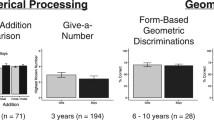Abstract
This study examined the relationships among five measures that assess various cognitive components of the child's acquisition of gender. At around 2 years of age, children were given a task assessing their ability to accurately label as “a boy” or “a girl” some head-and-shoulders pictures of boys and girls. At 4 years of age, these children were given tasks measuring (1) the degree to which they found gender a salient parameter of categorization, (2) the amount of gender-related knowledge they could display (SERLI-SRD), (3) the degree to which their preferences were gender-typed (SERLI-SRP) and (4) the accuracy of their memory for gender-typed information. There was no consistent pattern of relationship among the children's scores on these five tools for measuring gender acquisition. Our findings suggest that gender is a multidimensional construct in children's development, and thus these results challenge the undimensional manner in which gender is repeatedly addressed in developmental theory and research.
Similar content being viewed by others
References
Bem, S. L. (1983). Gender schema theory and its implications for child development: Raising gender-aschematic children in a gender schematic society. Signs, 8, 598–616.
Bem, S. L. (1981). Gender schema theory: A cognitive account of sex typing. Psychological Review, 88, 354–364.
Brown, D. G. (1956). Sex-role preference in young children. Psychological Monographs, 70, No. 421.
Edelbrock, C., & Sugawara, A. I. (1978). Acquisition of sex-typed preferences in preschool children. Developmental Psychology, 14, 614–623.
Fagot, B. I., & Leinbach, M. D. (1989). The young child's gender schema: Environmental input, internal organization. Child Development, 60, 663–672.
Fagot, B. I. Leinbach, M. D., & Hagan, R. (1986). Gender labeling and the adoption of sex-typed behaviors. Developmental Psychology, 22, 440–443.
Fauls, L. B., & Smith, W. D. (1956). Sex-role learning of five-year-olds. Journal of Genetic Psychology, 89, 105–117.
Hort, B. E., Leinbach, M. D., & Fagot, B. I. (1989). A sex difference in the strategies for categorizing social information: Differential socialization or developmental decalage? Unpublished manuscript, University of Oregon, Eugene.
Huston, A. C. (1983). Sex-typing. In P. H. Mussen (Ed.), Handbook of child psychology (4th ed., Vol. 4). New York: Wiley.
Leinbach, M. D., & Fagot, B. I. (1986). Acquisition of gender labels: A test for toddlers. Sex Roles, 15, 655–666.
Martin, C. L., & Halverson, C. F. (1981). A schematic processing model of sex typing and stereotyping in children. Child Development, 52, 1119–1134.
Martin, C. L., & Halverson, C. F. (1983). The effects of sex-typing schemas on young children's memory. Child Development, 54, 563–573.
Sears, R. R., Rau, L., & Alpert, R. (1965). Identification and child rearing. Stanford, CA: Stanford University Press.
Serbin, L. A., & Sprafkin, C. (1986). The salience of gender and the process of sex typing in three- to seven-year-old children. Child Development, 57, 1188–1199.
Smith, L. B. (1984). Young children's understanding of attributes and dimensions: A comparison of conceptual and linguistic measures. Child Development, 55, 363–380.
Author information
Authors and Affiliations
Additional information
This research was funded in part by a federal biomedical research grant (No. 2507RR07080) awarded to the first author from the Department of Psychology at the University of Oregon, and by Grant No. RO1HD175751 from the National Institute of Child Development awarded to the third author.
We wish to thank Margo Lane, Rachel Robertson, Jacqui Oucalt, Laura Baker, Dale Roberts, and the teachers, parents, and assistants of the Child Research Laboratory at the University of Oregon in Eugene, Oregon, for their invaluable contribution to this research.
Rights and permissions
About this article
Cite this article
Hort, B.E., Leinbach, M.D. & Fagot, B.I. Is there coherence among the cognitive components of gender acquisition?. Sex Roles 24, 195–207 (1991). https://doi.org/10.1007/BF00288891
Issue Date:
DOI: https://doi.org/10.1007/BF00288891




